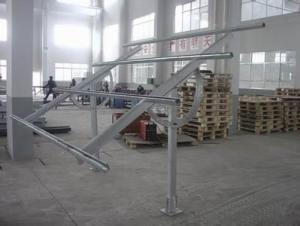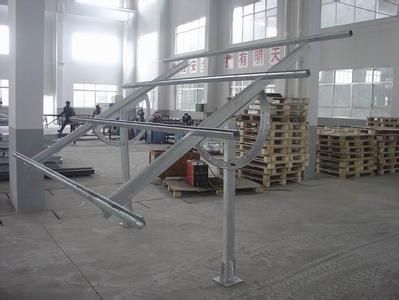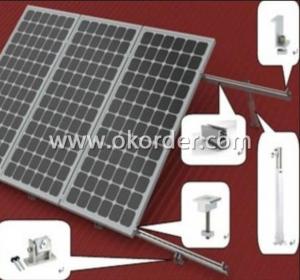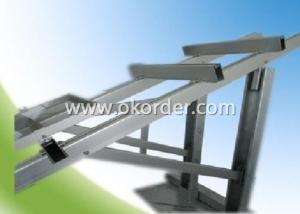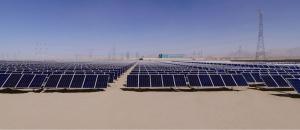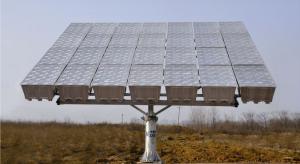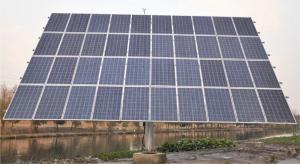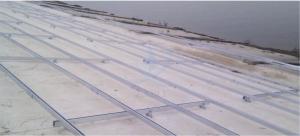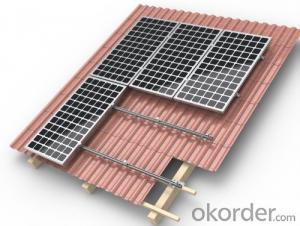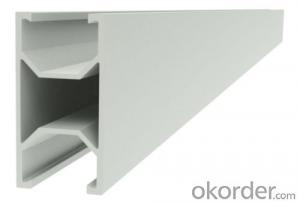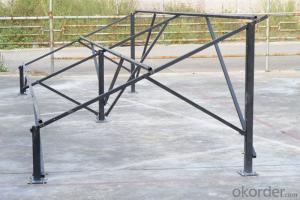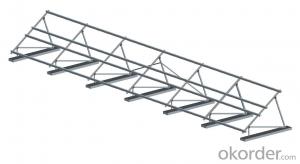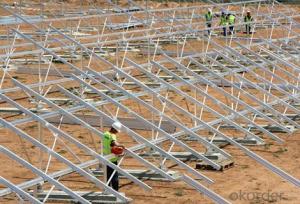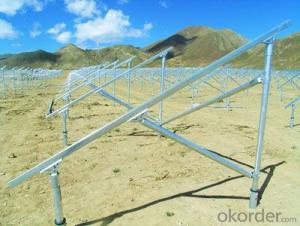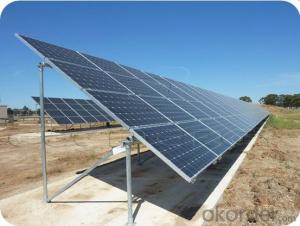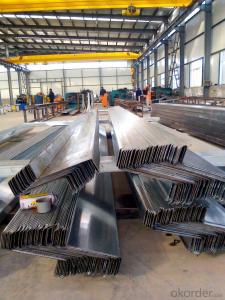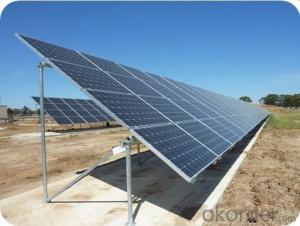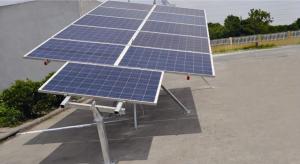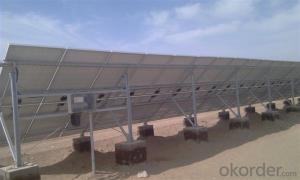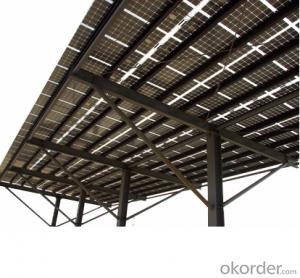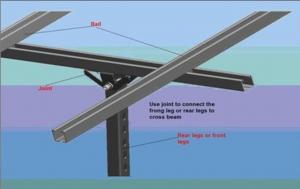Solar Panel Monting System TT-RK-03
- Loading Port:
- Shanghai
- Payment Terms:
- TT OR LC
- Min Order Qty:
- -
- Supply Capability:
- 50万套 set/month
OKorder Service Pledge
OKorder Financial Service
You Might Also Like
PV Mounting brackets are special solar photovoltaic systemfor placing, installing, fixing the solar panel design. Generally materials arealuminum, steel structure, stainless steel. PV mounting products at groundmounting system, flat roof mounting system, adjustable angle roof rack system,inclined roof rack system, column bracket system.
The Ground Mounting System including concret basement sysytemand steel pipe sysytem, Titanergy provides total solution for flat or pitchedroof with patent products.On the basis of the given project data, specificnational standards and guidelines, Titanergy will calculate the completestructural analysis and create a complete project plan to make sure reliablestructural safety.We provide high quality HDG steel and aluminum products forthe ground mounting sysytem,witch can make sure the security and durability ofthe project.
Features and Advantages
n The rail bracket is easy to install, just use simple tools(eg, Allen wrench) can be easily installed. Rail connecting member can freelyadjust the length, the stent may be pre-installed on the roof, and thenappropriately adjusted according to the size of the solar panel.
n The combination of strong, aluminum rails and card blocks fora variety of venues and a variety of materials roofs (such as metal, ceramicand other kinds of tile surface)
n Component compatibility, and rail can meet PV modules fromdifferent manufacturers.
n accuracy, the length of the rail to the nearest millimeter,the construction process, not because of the length is too long or too shortfor the second cut.
n flexible assembly, rail hooks can adjust the spacing modulearray and tile has been installed successfully address the uneven roofconstruction led to difficult problems.
n design standards, product design and development process instrict accordance with GB, the German standards and other internationalstandards to ensure products reach the world advanced level.
n Quality assurance, the stent main material is high-qualityaluminum and stainless steel, effectively prevent corrosion of oxidation.Products can be recycled, reducing environmental pollution.
n Carried out strictly according to the current specificnational standards
n Perfectly optimized components and complete structuralanalysis for the sysytem
n High corrosion resisitance ensure the stability and highdurability
n Total test and certification make sure the high quality ofthe products
n Maximum pre-assembled in factory,quick mounting onsite,timesaving
10-year durability warranty
Technical Data
n Design Period:25 years
n Installation Site: Open area
n Array Angle:10°~60°
n ModuleType:Framed or unframed
n Material:Q235B,Al 6063-T5,Al 6005-T5,StainlessSteel A2-70
n Coating:HDG/Anodised
- Q: Are there any specific requirements for solar tracker compatibility when using a solar mounting system?
- Yes, there are specific requirements for solar tracker compatibility when using a solar mounting system. The solar mounting system needs to be designed and built to accommodate the movement and requirements of a solar tracker. This includes factors such as weight, size, and range of motion of the tracker, as well as the ability to withstand wind loads and maintain structural integrity. It is crucial to ensure that the solar mounting system is compatible with the specific solar tracker being used to ensure optimal performance and functionality.
- Q: How does a solar mounting system work?
- A solar mounting system is designed to securely hold solar panels in place and optimize their performance. It typically consists of a structure or framework that is anchored to the ground or a building rooftop. The solar panels are then mounted onto this structure using brackets or clamps. The system is engineered to ensure the panels are tilted at an optimal angle to receive maximum sunlight throughout the day. Additionally, the mounting system provides a safe and stable platform for the panels, protecting them from harsh weather conditions and potential damage.
- Q: How does the cost of a solar mounting system compare to the cost of solar panels?
- The cost of a solar mounting system is typically lower compared to the cost of solar panels. While the cost of solar panels can vary depending on factors such as brand, quality, and efficiency, the cost of a solar mounting system is generally a smaller portion of the overall installation cost. This is because solar panels make up a significant portion of the total system cost, while the mounting system is typically a smaller component that helps secure and position the panels.
- Q: Can solar mounting systems be installed in areas with heavy snowfall?
- Yes, solar mounting systems can be installed in areas with heavy snowfall. However, it is important to design and install the system properly to ensure its durability and functionality in such conditions. Snow loads and the angle of the solar panels need to be considered to prevent snow build-up and allow for efficient snow shedding. Additionally, regular maintenance such as clearing off snow when needed may be required to maximize the system's performance in snowy regions.
- Q: Can a solar mounting system be installed on a rooftop with a gambrel roof?
- Yes, a solar mounting system can be installed on a rooftop with a gambrel roof. However, it may require additional engineering and customization to ensure proper installation and optimal solar panel positioning.
- Q: What is the expected efficiency of a solar mounting system?
- The expected efficiency of a solar mounting system can vary depending on factors such as the type of mounting system, the angle and orientation of the solar panels, and the location's climate and sunlight availability. Generally, a well-designed and properly installed solar mounting system can achieve an efficiency between 80% and 90%, meaning that it can capture and convert 80% to 90% of the available solar energy into electricity.
- Q: Are there any specific requirements for wiring when using a solar mounting system?
- Yes, there are specific requirements for wiring when using a solar mounting system. The wiring should be properly sized to handle the current generated by the solar panels and should be installed according to the National Electrical Code (NEC) guidelines. Additionally, the wiring should be protected against weather elements and properly grounded to ensure safety and optimal performance of the system.
- Q: Which type of solar mounting system is best for residential installations?
- The best type of solar mounting system for residential installations is typically the rooftop mounting system.
- Q: Are there disadvantages to using a ground-mounted solar mounting system?
- Yes, there are some disadvantages to using a ground-mounted solar mounting system. Firstly, ground-mounted systems require a significant amount of land, making them unsuitable for locations with limited space. Additionally, the installation process for ground-mounted systems can be more complex and time-consuming compared to rooftop systems. Ground-mounted systems also need proper maintenance to prevent vegetation growth and shading, which can reduce the efficiency of the solar panels. Lastly, ground-mounted systems may be more susceptible to theft or vandalism due to their accessibility.
- Q: Are there any specific requirements for installing solar mounting systems in desert environments?
- Yes, there are specific requirements for installing solar mounting systems in desert environments. These include selecting materials that can withstand extreme temperatures, high winds, and blowing sand. The mounting system should also be designed to minimize the accumulation of dust and sand on the solar panels to maintain their efficiency. Additionally, proper foundation and anchoring systems are necessary to ensure stability in sandy soil or rocky terrain.
Send your message to us
Solar Panel Monting System TT-RK-03
- Loading Port:
- Shanghai
- Payment Terms:
- TT OR LC
- Min Order Qty:
- -
- Supply Capability:
- 50万套 set/month
OKorder Service Pledge
OKorder Financial Service
Similar products
Hot products
Hot Searches
Related keywords
